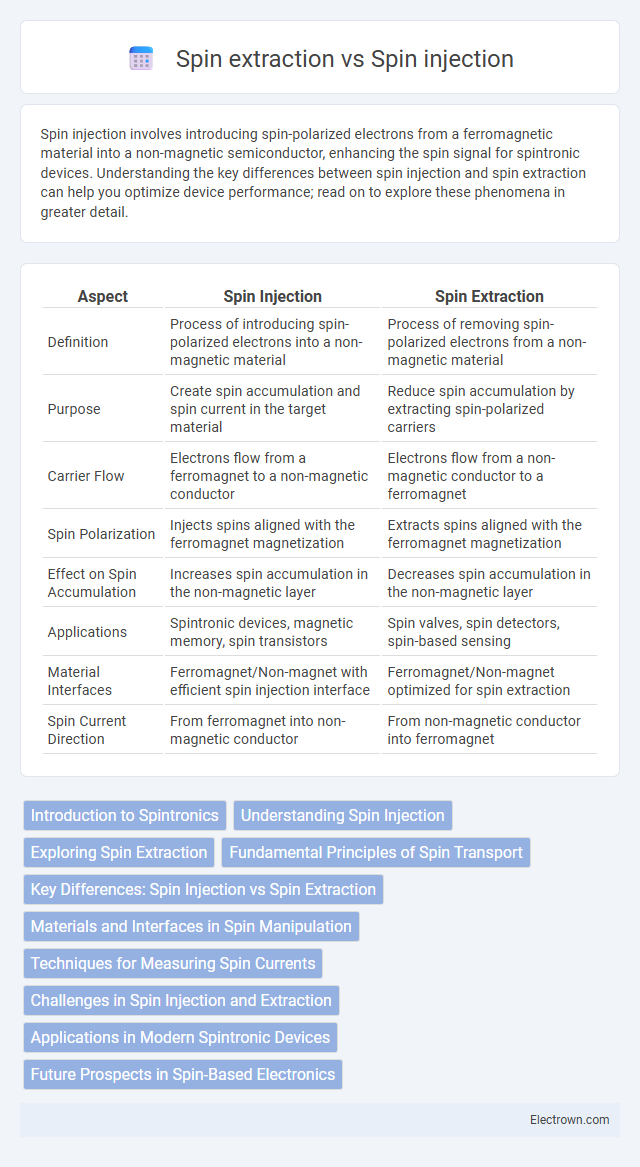Spin injection involves introducing spin-polarized electrons from a ferromagnetic material into a non-magnetic semiconductor, enhancing the spin signal for spintronic devices. Understanding the key differences between spin injection and spin extraction can help you optimize device performance; read on to explore these phenomena in greater detail.
Table of Comparison
| Aspect | Spin Injection | Spin Extraction |
|---|---|---|
| Definition | Process of introducing spin-polarized electrons into a non-magnetic material | Process of removing spin-polarized electrons from a non-magnetic material |
| Purpose | Create spin accumulation and spin current in the target material | Reduce spin accumulation by extracting spin-polarized carriers |
| Carrier Flow | Electrons flow from a ferromagnet to a non-magnetic conductor | Electrons flow from a non-magnetic conductor to a ferromagnet |
| Spin Polarization | Injects spins aligned with the ferromagnet magnetization | Extracts spins aligned with the ferromagnet magnetization |
| Effect on Spin Accumulation | Increases spin accumulation in the non-magnetic layer | Decreases spin accumulation in the non-magnetic layer |
| Applications | Spintronic devices, magnetic memory, spin transistors | Spin valves, spin detectors, spin-based sensing |
| Material Interfaces | Ferromagnet/Non-magnet with efficient spin injection interface | Ferromagnet/Non-magnet optimized for spin extraction |
| Spin Current Direction | From ferromagnet into non-magnetic conductor | From non-magnetic conductor into ferromagnet |
Introduction to Spintronics
Spin injection and spin extraction are fundamental processes in spintronics, where the manipulation of electron spin, rather than charge, enables advanced data storage and processing. Spin injection involves introducing spin-polarized electrons from a ferromagnetic material into a non-magnetic semiconductor, enhancing your device's magnetic response and spin coherence. Conversely, spin extraction removes spin-polarized electrons from the semiconductor, enabling precise control of spin currents and improving spintronic device efficiency.
Understanding Spin Injection
Spin injection involves introducing spin-polarized electrons from a ferromagnetic material into a non-magnetic semiconductor, enhancing spintronic device performance by enabling efficient spin current generation. Understanding the mechanisms of spin injection requires examining interface properties, spin diffusion lengths, and electron spin polarization levels to optimize spin transfer. Your ability to control spin injection impacts the development of advanced memory and logic devices relying on spin-based information processing.
Exploring Spin Extraction
Spin extraction involves removing spin-polarized electrons from a material, enhancing control over spin currents in spintronic devices. This process plays a crucial role in manipulating spin accumulations and enables efficient spin-based information processing compared to traditional spin injection methods. By optimizing interface materials and spin-selective contacts, spin extraction offers improved performance in non-volatile memory and quantum computing applications.
Fundamental Principles of Spin Transport
Spin injection involves the transfer of spin-polarized electrons from a ferromagnetic material into a non-magnetic semiconductor, creating a net spin polarization in the latter. Spin extraction refers to the removal of spin-polarized electrons from the semiconductor back into the ferromagnet, reversing the spin accumulation at the interface. Both processes rely on spin-dependent conductivity and interface spin resistance, governed by the spin diffusion length and spin relaxation mechanisms within the materials.
Key Differences: Spin Injection vs Spin Extraction
Spin injection involves introducing spin-polarized electrons from a ferromagnetic material into a non-magnetic semiconductor, enhancing spin accumulation and enabling spintronic device functionality. Spin extraction, conversely, refers to the removal of spin-polarized electrons from the semiconductor back into the ferromagnet, reducing spin accumulation within the semiconductor channel. The key differences lie in the direction of spin flow, the resulting spin population in the semiconductor, and their respective roles in controlling spin currents in spintronic applications.
Materials and Interfaces in Spin Manipulation
Spin injection and spin extraction rely heavily on the choice of materials and interface engineering to optimize spin manipulation efficiency. Ferromagnetic metals such as cobalt or iron combined with semiconductor interfaces like GaAs or silicon create favorable conditions for spin polarization and minimal spin scattering. Your ability to control interface quality and material spin polarization directly influences spin transfer rates crucial for spintronic device performance.
Techniques for Measuring Spin Currents
Techniques for measuring spin currents in spin injection and spin extraction involve non-local spin valve measurements, where spin accumulation is detected away from the charge current path, enabling precise quantification of spin polarization and diffusion length. Spin-polarized tunneling spectroscopy uses ferromagnetic tunnel junctions to analyze spin-dependent electron transport, offering high sensitivity for distinguishing injection versus extraction processes. You can also utilize spin Hall effect measurements to convert spin currents into measurable transverse voltages, providing a powerful tool for evaluating spin flow dynamics in various materials.
Challenges in Spin Injection and Extraction
Spin injection faces challenges such as conductivity mismatch between ferromagnetic materials and semiconductors, leading to low spin polarization efficiency and limited spin current generation. Spin extraction struggles with maintaining spin coherence and controlling spin relaxation at interfaces, which often results in reduced spin signal detection and efficiency. Optimizing interface quality and material selection is crucial for improving your device performance in both spin injection and extraction processes.
Applications in Modern Spintronic Devices
Spin injection and spin extraction are critical processes for manipulating electron spin in modern spintronic devices, enabling high-efficiency information storage and processing. Spin injection involves introducing spin-polarized electrons into a non-magnetic material, crucial for developing magnetic tunnel junctions and spin transistors used in MRAM technologies. Spin extraction, by contrast, removes spin-polarized electrons and is essential for optimizing spin current detection and enhancing device performance in spin-based logic and sensing applications.
Future Prospects in Spin-Based Electronics
Spin injection and spin extraction techniques are critical for advancing spin-based electronics, offering pathways to improve spin polarization control and efficiency in spintronic devices. The future prospects include enhanced data storage, non-volatile memory applications, and ultra-low power logic circuits by exploiting efficient spin manipulation. Developing materials with high spin coherence and reliable interfaces will drive innovations in quantum computing and spin-based information processing technologies.
Spin injection vs Spin extraction Infographic

 electrown.com
electrown.com